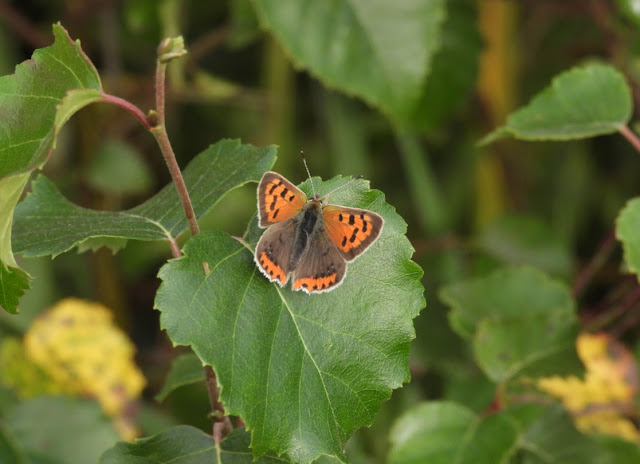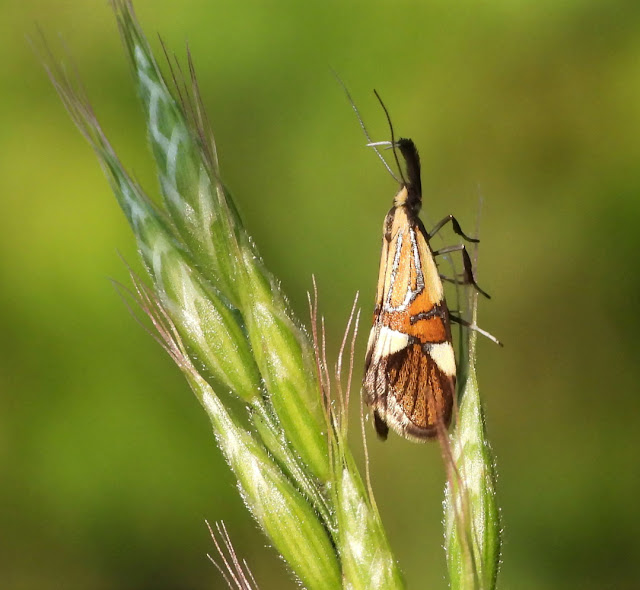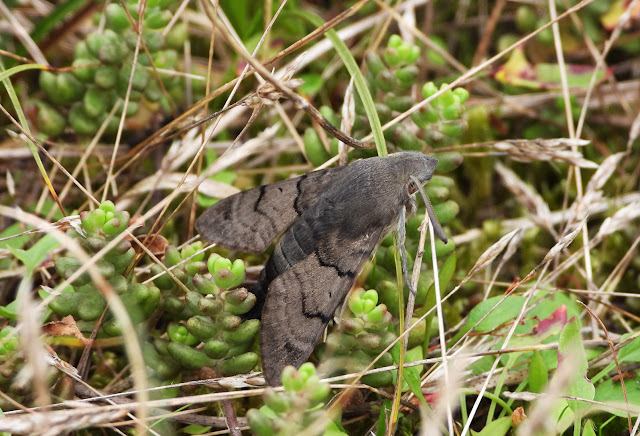Butterflies
The first of the year was a Red Admiral on 7th February, beating the other regular contender for the earliest species - Peacock by twelve days. Red Admiral peaked during the autumn with three figure numbers recorded passing through the reserve on several days. The last date was 11th December. The more sedentary Peacock was recorded on 42 occasions with generational peaks in April and July. The last date being 8th October.
It wasn't until April that further butterflies made an appearance with a typical showing of Large White and Speckled Wood on 6th. The last Large White was on 8th October and the last Specked Wood was on the late date of 7th November. The first Brimstone was on 7th, it was a relatively good showing this year for this occasional visitor; with other singles on 28th April, 1st & 14th May; four on 13th May was noteworthy, a day of insect migration.
Other April butterflies included Small Tortoiseshell on 7th, no longer numerous on site, with just six appearances of singles were between April and August is typical. Small Copper were on the wing from 13th with almost continuous sightings of overlapping broods until the last record on 8th October.
Orange-tip have a more confined flight period with the first on 14th April and last on 8th June. After a very low ebb, good to see an increasing breeding population with territorial behaviour and egg laying noted.
The usually numerous Comma had a very poor year on site with just five appearances, the first on 18th April, two in July and two in September. Wall Brown continues to retain a foothold on site, only four sightings this year, but more than recent years; the first of three the spring generation was on 25th April with the only summer generation sighting on 27th July.
Into May; Holly Blue were on the wing from 1st. A species that had a good year; recorded on eleven days with a spring generation peak of five on 15th May. The first of the summer generation was seen on 18th July, with four on the 16th August the last reports of the year.
Painted Lady occurrences tend to be cyclical with this year being a low for this migratory species. There were records on sixteen days from 4th May with four further records in July; the remainder were in September and October, with the last sighting of the year on 30th October.
Green-winged White were recorded on eleven dates between 10th May to 9th September. The related Common Blue and Brown Argus first appeared on the same date of 12th May. A typical showing this year, Common Blue were recorded on 53 dates until 10th October. Brown Argus, occupying more open areas were recorded nineteen times up to 14th September. Small White were on the wing from 13th May. Predominately recorded as a migratory species numbers peaked in September. The last sighting was on 14th October.
A Green Hairstreak on 29th May was the first for five years, the equally elusive Purple Hairstreak was not recorded, hopefully just missed, this year. The first Meadow Brown appeared on the 30th May; this common butterfly was ever present up to 10th October.
Large Skipper were on the wing between 4th June and 13rd July, with the more numerous Small Skipper between 23rd June and 29th July. The migratory Clouded Yellow was recorded on eight dates between 8th June and 11th October, with two on 23rd September and 3rd October, numbers down on 2022. The first Gatekeeper of the year was recorded on 15th June. One of the commonest summer butterflies, typical for this species, its flight season finished abruptly with the last sighting on 22nd August.
The last two species to appear were Marbled White on 23rd June and Ringlet on 29th June, both were notably scarce this year with just three Ringlet and one other Marbled White recorded.
Moths
A total of 312 species were recorded during the year, with 152 of these only seen at light traps set on three nights; 11th & 27th June and 7th September. The rest were mostly from leafmines, with occasional adult and other larval records.
Despite the paucity of trapping, a further 10 species were added to the Warren audit, including five ‘macro’ moths.
Half of these were species expanding their range, aided by climate change; Beautiful Pearl Agrotera nemoralis, Hemlock Yellow Conch Aethes beatricella, Rosy-striped Knot-horn Oncocera semirubella, Brown Ash Ermine Zelleria hepariella and Dewick’s Plusia.
Rosy-striped Knot-horn Oncocera semirubella - Luke Harman
Others included a number of presumably overlooked species such as White-speckled Bagworm Narycia duplicella, Treble Brown Spot and Muslin Footman.
Muslin Footman - Kevin Rylands
July Belle and Small Clouded Brindle were both recorded following unconfirmed records in the 1980s.
Recent discoveries still finding the Warren to their liking included the nationally scarce New Marsh Cosmet Cosmopterix scribaiella, Least Carpet and Portland Ribbon Wave with Alexanders Conch Aethes deaurana and Box-tree Moth Cydalima perspectalis confirmed breeding on site.
A Hummingbird Hawkmoth caterpillar was found for the first time on site and a small unexpected second brood of Crescent Plume Marasmarcha lunaedactyla were found on 9th September.
Over 30 other species were recorded for the first time in at least five years with seven not seen for 15 years including May Highflier, Obscure Wainscot and Scarce Silver-lines.
Six more were recorded for the first time in up to 25 years, with a Shoulder Stripe on 6th March the first since 1984 and the Nationally Scarce Six-belted Clearwing at Langstone Rock on 16 August the first since July 1958.
Local specialties recorded included Sand and White-line Dart, Fen and Shore Wainscot, Waste Grass-veneer Pediasia contaminella, Sandhill Anerastia lotella and Gorse Knot-horn Pempelia genistella.
White-line Dart - Luke Harman
Day-flying species included Cinnabar from 10th May, Green Adela reaumurella and Meadow Longhorn Cauchas rufimitrella, Common Tubic Alabonia geoffrella and Yellow Shell in May, Six-spot Burnet from 19th June, Pellitory Cosmet Cosmopterix pulchrimella in July and Mint Moth Pyrausta aurata in August.
Other colourful crowd pleasers included Cream-spot, Jersey and Scarlet Tiger, Eyed & Privet Hawkmoth, Canary-shouldered Thorn and Swallow-tailed Moth.
Jersey Tiger - Alan Keatley
The first migrant was an early Rush Veneer Nomophila noctuella on 6th April, with a Diamondback Plutella xylostella on 30th April, the first Silver Y arrived on 19th May with records through to 23rd November. Hummingbird Hawkmoth were recorded between 25th May and 11th October.
Hummingbird Hawkmoth - Lee Collins
A Dark Sword-grass and Small Mottled Willow were trapped on 27th June, with the first Rusty-dot Pearl Udea ferrugalis on 12th August. The first of six Vestal reported was on Warren Point on 3rd September, the last on 8th October and an adult Convolvulus Hawkmoth was found on the Golf Course on 12th September.
Over 40 species were recorded from leafmines including Gorse Midget Phyllonorycter ulicicolella, New Holm-Oak Pigmy Ectoedemia heringella, Birch Lift Heliozela hammoniella, Kent Bent-wing Phyllocnistis xenia and Fleabane Smudge Digitivalva pulicariae.
Other larvae included tents of Brown-tail, Buff-tip and Lackey with Cream-spot and Ruby Tiger seen searching for pupation sites and Angle Shades, Alder Moth, Dingy Footman, Puss Moth and Vapourer.






















No comments:
Post a Comment